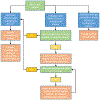Cardiovascular Genetics: The Role of Genetics in Predicting Risk
- PMID: 35227433
- PMCID: PMC8894793
- DOI: 10.1016/j.mcna.2021.11.007
Cardiovascular Genetics: The Role of Genetics in Predicting Risk
Abstract
Many cardiovascular disorders have underlying genetic causes. Clinical genetic testing for cardiovascular disease has become widely available and can be useful for diagnosis, management, and cascade screening in selected conditions and circumstances. This article gives an overview of the current state of genetic testing in inherited cardiovascular conditions, who can benefit from it, and the associated challenges.
Keywords: Cardiovascular genetics; Cascade screening; Genetic counseling; Genetic testing; Inherited cardiovascular disease; Precision medicine.
Published by Elsevier Inc.
Conflict of interest statement
Disclosure Dr A.T. Owens is a consultant for MyoKardia and Cytokinetics and receives funding from the Winkelman Family Fund for Innovation. Dr N. Reza is supported by the National Center for Advancing Translational Sciences of the National Institutes of Health under award number KL2TR001879. The content is solely the responsibility of the authors and does not necessarily represent the official views of the National Institutes of Health.
Figures




References
-
- Mainous AG 3rd, Johnson SP, Chirina S, et al. Academic family physicians’ perception of genetic testing and integration into practice: a CERA study. Fam Med 2013;45(4):257–62. - PubMed
-
- Ahmad F, McNally Elizabeth M, Ackerman MJ, et al. Establishment of Specialized Clinical Cardiovascular Genetics Programs: Recognizing the Need and Meeting Standards: A Scientific Statement From the American Heart Association. Circ Genomic Precis Med 2019;12(6):e000054. - PubMed
-
- Ingles J, Semsarian C. Making the case for cascade screening among families with inherited heart disease. Heart Rhythm 2020;17(1):113–4. - PubMed
-
- Adaptation and validation of the ACMG/AMP variant classification framework for MYH7-associated inherited cardiomyopathies: recommendations by ClinGen’s Inherited Cardiomyopathy Expert Panel - ClinGen | Clinical Genome Resource. Available at: https://www.clinicalgenome.org/docs/adaptation-and-validation-of-the-acm.... Accessed April 16, 2021. - PMC - PubMed
Publication types
MeSH terms
Grants and funding
LinkOut - more resources
Full Text Sources
Medical

